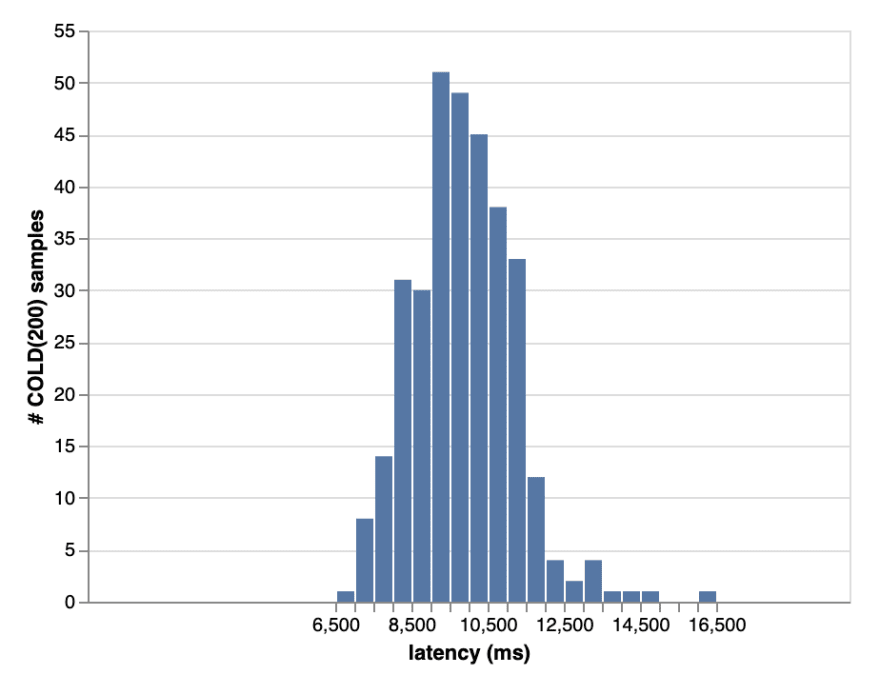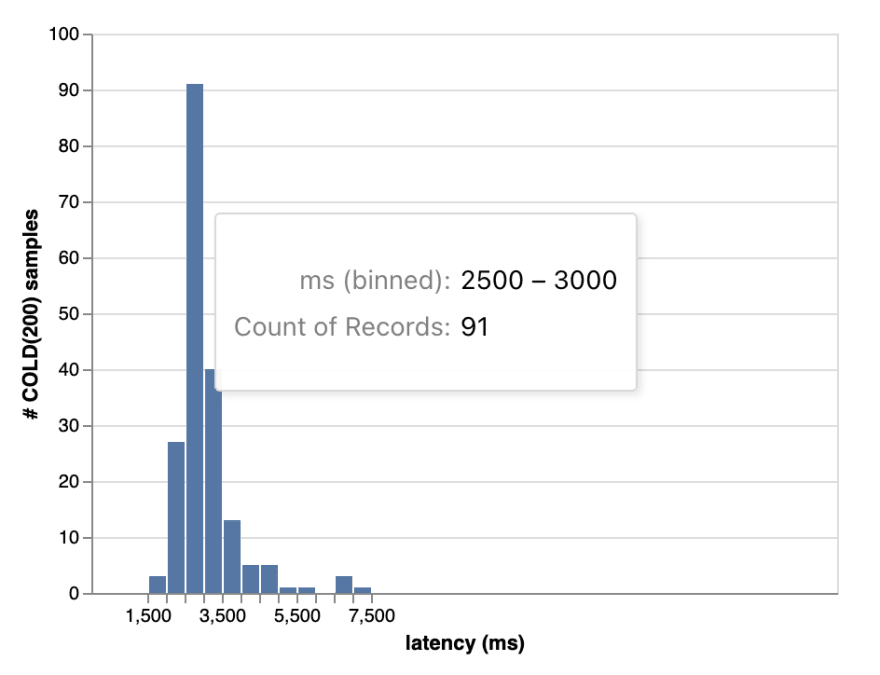Cloud Run is interesting, it's a general-purpose elastic container hosting service, a bit like Fargate or Azure-Containers but with a few critical differences.
Most interesting is that it scales to zero, and auto-scales horizontally, making it very cost-effective for low traffic jobs (e.g. overnight batch processes).
It also runs arbitrary docker containers and can serve requests concurrently, meaning that for modest traffic you don't usually need more than 1 instance running (and you save money).
Its flexibility comes at the cost of higher cold starts though. Take a look at our cold start latencies for an on-demand puppeteer service in a low traffic region:
We are seeing cold start latencies of around 10 seconds, to boot up a 400MB container and start Chrome. This was annoyingly slow.
Not all our regions were that slow though, in one of the busier regions we saw a bimodal latency graph:
suggesting that 2.5 seconds is booting up a puppeteer instance and serving the request, and 5-7 seconds is booting the container. For busier regions often a container is running so that's why sometimes the cold latencies are much lower. (for completeness a warm latency measurement is 1.5 seconds, so probably 1 second is booting chrome, and 1.5 seconds is serving the request).
So... how could we speed things up? 5-7 seconds is spent on container startup. It's our biggest spender of the latency budget, so that's what we should concentrate on reducing.
One solution is to run a dedicated VM, though that loses the horizontal elasticity. Even so, let's do the numbers.
A 2 vCPU 2GB RAM machine (e2-highcpu-2) is $36.11 per month
Now Cloud Run has a relatively new feature called min-instances.
This keeps some containers IDLE but with no CPU budget, so they can be flipped on quicker. IDLE instances are still charged, BUT, at around a 10x reduced cost. The cost for an IDLE 2 vCPU 2GB RAM Cloud Run is $26.28 per month.
This gets pretty close to having your cake and eating it. You get lower latency like a dedicated machine, but also still horizontally elastic. It may even cost less.
For our application, we tried a min-instance of 1 and this was the result.
Our cold start latencies from container startup are decimated! We have not had to change any code.
I think this min-instances feature is a game-changer for cloud architecture. You can now get the benefits of dedicated VMs at a comparable price to dedicated VMs but with elasticity and image-based deployments. The new min-instances feature broadens the range of applications that serverless compute can address.
Our latency monitoring infrastructure and data is public.









Top comments (3)
I was so happy when they finally added this!
Another great solution (now thankfully no longer necessary): I was using Cloud Scheduler and creating separate
warm-[service]jobs for each individual Cloud Run service that I needed to have always available. This would effectively just hit the service once every 10min-15min to ensure that Cloud Run would either keep the container around or, more importantly, spin one up due to the latest request so that this headless task (from Cloud Scheduler) would take the brunt of that initial startup penalty so that regular end users wouldn't have to.It was particularly tedious when they were authenticated services, since it required also configuring the task to include the Auth header and use a service account to authenticate (more info on how to do that here).
Oh, I forgot to mention: They finally also added the ability to put Cloud Run services behind their Cloud Load Balancers, which is awesome. Now you can benefit from all sorts of additional features such as custom SSL certificates and Cloud Armor as well. This is actually old news as it turns out (July 16, 2020) but I'm still excited to take advantage of it when I get the chance.
cloud.google.com/blog/products/net...
yeah I used to do this too!